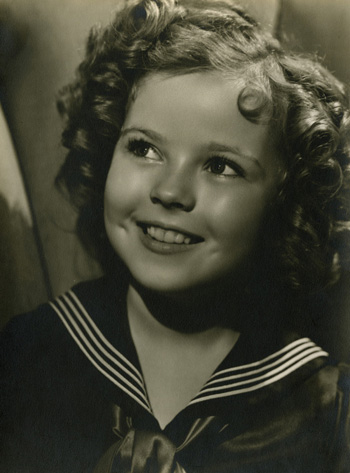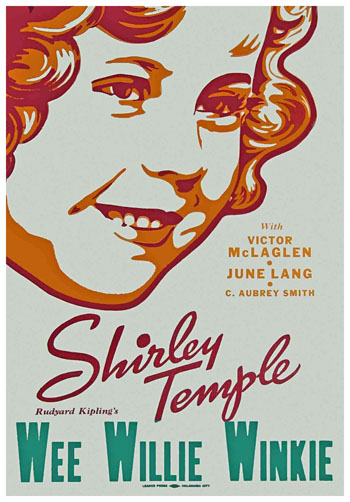“Shirley Temple Black, who as a dimpled, precocious and determined little girl in the 1930s sang and tap-danced her way to a height of Hollywood stardom and worldwide fame that no other child has reached, died on Monday night,” reports Aljean Harmetz in the New York Times. “Ms. Black returned to the spotlight in the 1960s in the surprising new role of diplomat, but in the popular imagination she would always be America’s darling of the Depression years, when in 23 motion pictures her sparkling personality and sunny optimism lifted spirits and made her famous. From 1935 to 1939 she was the most popular movie star in America, with Clark Gable a distant second. She received more mail than Greta Garbo and was photographed more often than President Franklin D. Roosevelt.”
“Roosevelt marveled how splendid it was ‘that for just 15 cents, an American can go to a movie and look at the smiling face of a baby and forget his troubles,'” notes Valerie J. Nelson in the Los Angeles Times. “By 1935, lookalike Shirley Temple dolls, complete with her trademark curls, were selling at the rate of 1.5 million a year, part of a merchandising onslaught that included Temple-endorsed dresses and dishes. Even bartenders got into the act. Although the 1930s origins of the non-alcoholic Shirley Temple cocktail have been debated, Temple told the Times in 1985 that the Brown Derby restaurant in Hollywood had named the drink after her.”
“As a child, her movies made her a heroine for adults as well as children,” writes Claudia Levy in the Washington Post. “Simplistic plots often cast her as a motherless tyke who found happiness and shared it, cheerfully singing or dancing her way out of trouble and spreading cheer wherever she went. She first sang her signature song, ‘On the Good Ship Lollipop’ in the movie Bright Eyes, one of nine films she made in 1934 alone…. Writer Charles Eckert observed that Shirley Temple played characters whose ‘capacity for love was indiscriminate, extending to pinched misers or to common hobos. It was a social, even a political force on a par with the idea of democracy or the constitution.'”
“In Stowaway (1936), she displayed her considerable talents by impersonating Eddie Cantor, Al Jolson and Ginger Rogers (dancing with a Fred Astaire doll),” writes Ronald Bergan in the Guardian. “She also demonstrated her dancing skills in numbers with the great tap-dancer Bill ‘Bojangles’ Robinson in four musicals. His deceptively easygoing tapping proved the ideal accompaniment to little Shirley’s shuffle, as in the ‘Polly Wolly Doodle’ stair routine in The Littlest Rebel (1935). No matter how one views Shirley Temple, and even for those who are allergic to precocious child performers, there has been no other child star before or since who has been as popular or demonstrated such extraordinary talents as singer, dancer and actor.”
“As ‘Morelegs Sweet-trick’ she parodied Marlene Dietrich,” notes Nigel Andrews in the Financial Times, “while another of her characters, Madame Cradlebait, hinted at the precocious allure later noted by Greene in his review of Wee Willie Winkie (1937). Greene speculated that Temple was an adult impersonating a child and implied (claimed Twentieth Century Fox) that she had been procured by the studio for immoral purposes. Fox’s libel suit was to cost Greene’s magazine Night and Day so much that it was forced to close.”
Glenn Kenny: “She was an exceptional performer and by all accounts a bright and sane person, and she may have been her most on-the-mark critic when she put herself in the category of Rin-Tin-Tin, not by way of diminishing her own gifts, but in recognizing her precocious persona as a shiny object that could bring cheer to fed-up, downtrodden folks seeking distraction.”
Free viewing. SnagFilms is offering a selection of features starring the young Shirley Temple.
Updates, 2/21: “The appeal lies partly in the mystery of star quality,” writes Farran Nehme, “something Sheila O’Malley describes well: ‘She was a phenomenal performer. It is impossible, still, to watch her movies and not get sucked into who she is being, what she is bringing to the screen.’ When the Siren was in acting school, the catchphrase was ‘give it away.’ Temple gave—gives—everything in a scene. Children learn quickly and painfully that the world does not revolve around them. A kid watching a Shirley Temple movie gets a much sweeter version of life: A little girl who stops the show every time she sings or dances, and when the orchestra lays down its instruments, she runs around straightening out the adults…. Is it the least bit surprising that in Wee Willie Winkie (still the Siren’s favorite) Shirley handily solves an Indian diplomatic crisis? No wonder the adult Temple could sail through Czechoslovakia’s Velvet Revolution as the American ambassador.”
“She was,” writes Margaret Talbot, “on the one hand, the grown-up’s ideal daughter—radiant, ringletted, and adorable (her mother’s favorite stage direction was telling her to ‘sparkle’) but not a paragon. Her roles often called on her to break a few rules and to speak innocent truth to stuffy snobs. At a time when ingénues mostly giggled ingratiatingly, as the critic Gilbert Seldes pointed out, Temple laughed boisterously.”
Also writing for the New Yorker, Susan Burton recalls watching the films as a child in the early 1980s: “There was enormous power in watching her doing what I wanted to do—a little girl who I knew had been at the center not only of these films but also of the culture. There was something about the movies being old that mattered, too. There was a feeling of discovery, a feeling that Shirley was mine.”
Update, 3/3: “Historian Charles Eckert has argued that Depression-era discourse demanded that Temple’s labor be overwritten as a narrative of love and play, making her status as a worker ‘self-obliterating,'” notes Laura Fisher, writing for the New Inquiry. “And so the mythology goes: Shirley did not memorize lines and dance steps and spend hours posing for still photographs each day—she simply played…. Why do we need Shirley Temple to be a miracle?”
For news and tips throughout the day every day, follow @KeyframeDaily on Twitter and/or the RSS feed. Get Keyframe Daily in your inbox by signing in at fandor.com/daily.





